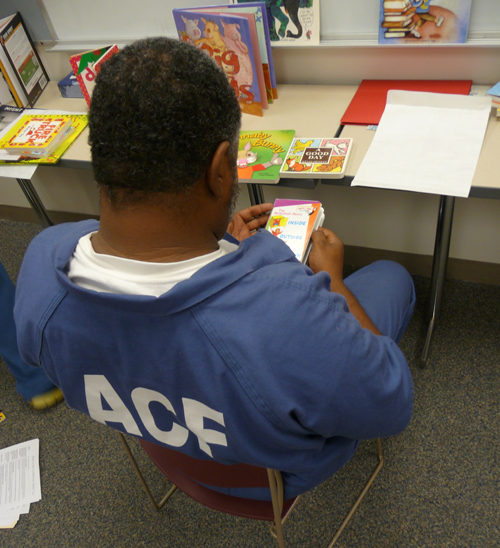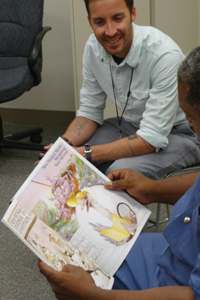
“Do you still like boxing?”
The question startled librarian Dan Marcou. He had been sitting quietly at a small town library outside of the system where he works, waiting for his wife to finish some grad school research. When he looked up, he didn’t recognize the face immediately, a man holding the hand of a young boy.
“Do you remember me? I’m James. We met at the workhouse,” the man continued.
With that, Marcou remembered James, a young father who had been incarcerated for a short time at the Hennepin County (Minn.) Jail, where Marcou has been a corrections librarian for the past eight years. While there, James had made a recording of himself reading a children’s book for his young son—the child he had now brought to the library.
It’s a moment Marcou says would make any librarian proud: Proof that a program he runs to help incarcerated parents learn to read to their kids had really made an impact.
Read to Me
Marcou’s program, Read to Me, is one of at least half a dozen around the country that helps incarcerated parents connect with their children at home by making a recording of themselves reading a children’s book. The parents are allowed to send the book and recording to their child, and they can often read the book during an in-person visit as well.
“Many of the folks I work with weren’t read to as children,” says Marcou. “Over the course of the program, they learn how to read a book to a child and [learn] that it’s really fun. At the end of the program, more than 90% of participants say they intend to take their kids to the library.”
When we connect parents and kids to the library, we create new library users for the future.—Lindsay Klick, children’s librarian at the Stanton branch of the Orange County (Calif.) Public Libraries
Read to Me—which received the Marshall Cavendish Excellence in Library Programming Award in 2004—has been operating since 1998 and is part of a larger relationship between the county’s libraries and correctional facilities that goes back 30 years.
Residents of the jail where Marcou works are there for a short period of time—most inmates serve about 40 days, and no one is there more than a year—so the program is condensed into three hourlong sessions over three weeks. In the first session, librarians demonstrate how to read aloud with fun, age-appropriate books and talk about the developmental impact of reading to kids. Over the next two sessions, inmates pick out books for their own children, practice reading them aloud, and record them with digital recorders. During the program, librarian facilitators talk about the library as a resource that can help the inmates as they reenter the community, making sure that every inmate has a library card and that any previous fines are waived. Six men and six women participate in the program each month.
The response from the inmates is overwhelmingly positive, saying the program provides them with a bridge to their kids during a difficult time. “I felt the Read to Me experience was a great opportunity to touch base with my child in the wake of my absence,” says Joey, a program participant. “It kept me alive when I was unable to be there to read to her.”
Joey’s daughter had a big reaction as well. “Immediately, her eyes lit up, and she raced full-speed to the [CD player] and bonked her head,” Joey says. “She didn’t hurt herself, but she bonked her head thinking I was in there.”
Seeing an impact

The number of kids with incarcerated parents has increased nearly 80% in the last 20 years, according to data from the Bureau of Justice Statistics. More than 2.7 million children have a parent who is incarcerated, and parents of another 10 million children have been incarcerated at some point. The experience can be profoundly difficult for children, increasing their risk of living in poverty and housing instability, as well as causing emotional trauma, pain, and social stigma. But librarian Sarah Ball, who runs the Daddy and Me program for the New York Public Library and the city’s corrections system, says she sees some of that stress melt away when kids are able to come to visit their parent and read their special book together.
“The kids light up when the books come out, which is music to our ears,” says Ball. “You actually don’t see the struggle in the kids during our family days. The kids want to read the books over and over again. They want to climb all over their parents and just have a good day. They seem much less fazed by the environment than you might expect.”
Ball sees the impact of her work not just in the books that are read on a visitation day or sent home but also in making reading aloud part of a family’s culture.
“We often hear, ‘My parents read to me, and I read to my kids,’ or ‘I don’t read to my kids, and I was never read to,’” says Ball. “It’s always pretty lined up. Parents determine whether the habit is passed on or not, and here they’re starting that habit.”
In that way, programs like these actually serve a library’s self-interest: creating new library patrons, says librarian Lindsay Klick, children’s librarian at the Stanton branch of the Orange County (Calif.) Public Libraries, who has studied library outreach to correctional systems nationwide.
“When we connect parents and kids to the library, we create new library users for the future,” says Klick.
And although many librarians might be reluctant to get involved in the seemingly difficult environment of a prison or jail, Klick says that serving the incarcerated hits on the essential mission of libraries—making information, books, and services available to anyone who needs them.
“The thing we need to remember is that most people are going to get out eventually. They’re going to be part of the community,” says Klick. “People might be a little bit worried about ‘those kinds of people’ coming to the library, but we’re here to serve everybody. Those are the kinds of people we can serve the most.”
Tips for Starting an Intergenerational Reading Program for Incarcerated Parents
1. Connect with someone in jail administration. The most important part of starting a program in your local correctional institution is to find someone who works there who will support it, Hennepin County Library’s Dan Marcou says. Establish a relationship with that person and ask for advice about how to move forward. Listen to everything he or she has to say and use that as your guide to the system, he says. In addition, it’s important to “work with the facility administration to let them know that [your program] is not going to impact the function or safety of the facility,” Marcou says.
2. Remember the setting. NYPL’s Sarah Ball says librarians shouldn’t be afraid of working in a corrections setting, but librarians do need to remember that the security of the facility will come before anything else. Often programs have to be canceled or changed at the last minute because of security concerns.
“Programs have to come second,” says Ball. “Corrections administrators understand that programs do support their goal of safety and security, but security always comes first.”
3. Find volunteers or staff and train them. While some programs like Read to Me use community volunteersfor help, Marcou says he also recruits Hennepin County librarians to run the programs to help build connections between the inmates and their local libraries. He notes that anyone brought into the corrections setting may need to go through training and background checks to comply with federal and state laws.
4. Think about your budget. Marcou says a program like Read to Me can be relatively low budget, depending on how it is run. Funding for Read to Me comes from the Friends of the Hennepin County Library and Target Corporation.
The cost depends on the program’s size and frequency. Marcou estimates that the cost for each child is about $5 to buy one to two books apiece, plus another $5 per envelope for postage to send the books and recordings home. Other costs include staff pay for the three program hours that they spend on-site, plus roughly two hours of orientation training. One-time workshops at the jail are also a low-cost option, Marcou says.
5. Stick to the rules. Prison rules may seem imposing or difficult to work with, but Marcou says every rule is there for a reason, and it’s important to work within the system. “We always have to be mindful of the fact that it’s their house,” he says. “Our good intentions are important, but they don’t trump prison regulations. If you believe in helping incarcerated parents, you also need to be willing to go through all of the extra steps to do it.”
Resources for Families Dealing with Incarceration
Mama Loves Me from Away (Boyds Mills, 2004) by Pat Brisson
Let’s Talk about When a Parent Is in Jail (PowerKids Press, 2003) by Maureen Wittbold
Visiting Day (Scholastic, 2002) by Jacqueline Woodson
The Year the Swallows Came Early (HarperCollins, 2011) by Kathryn Fitzmaurice
What Will Happen to Me? (Good Books, 2010) by Howard Zehr
Marcou also highly recommends Sesame Street’s Little Children, Big Challenges series, which includes a toolkit for families dealing with incarceration. The series has videos and stories for children as well as resources for care providers and community organizations on how to talk about incarceration, answer questions, and give kids a safe place to express their feelings.

